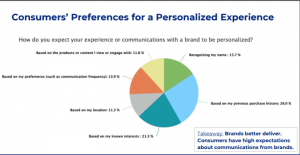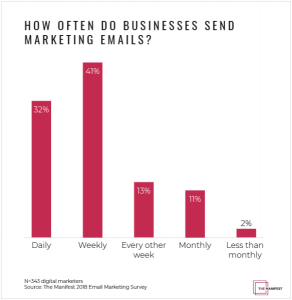We’ve been designing and developing websites for over 20 years and there’s one thing that remains constant and that one thing is change. There’s not another industry that I’m aware of that changes as rapidly and as dramatically as digital marketing, generally or website design and development, specifically.
According to Hubspot the average grade for websites that are run through their website grader app receive a score of 60.9 out of 100. That’s a D- grade.
With the increasing need for your website to support your business growth efforts, especially in today’s market, we felt it was an important topic to discuss and review the primary things to look at with your website to make sure that your site doesn’t get a failing grade.
We’re going to review four components that every business should pay close attention to when it comes to your website. These components are website goals, design & UX, mobile friendliness, and building trust with your website.
Even though there’s a lot more involved to making sure that your website is performing well, if you get these components right, you will be well on your way to having a website that doesn’t get a failing grade.
Goals and Planning
Whether you’re building a new website from scratch or you’re rebuilding a website that you have up for a while, the first step is to identify what, exactly you want your website to accomplish and then develop a plan for how to accomplish those goals.
In today’s market one of your first goals should be to develop a website that will allow your customers the ability to accomplish their goals on your site with as little effort as possible.
Here’s an example. Let’s say that one of your goals for your website is to generate more sales leads. To accomplish this goal, you’ll have to develop your website so that your customers can find your site, find information that they’re interested in, and gather information about your products or services as easily as possible.
To accomplish this goal you’ll have to carefully evaluate the information architecture (definition) of your website so that your customers will be able to find the information that they are looking for intuitively.
To take this example goal of increased leads one step further, recognize that you more than likely have multiple segments of customers who have different needs and potentially will require different information. Again, this will have an impact on your site’s information architecture and most likely the navigation within your website’s menu structure.
Make sure that you look at both sides of a goal; from your point of view and from your customer’s point of view.
Planning
Now that you’ve identified the goals that you have for your website, the different customers that you’re hoping to attract to your website, and what how you can help your customer’s achieve their goals on your website, as efficient as possible. Now, it’s time to turn your attention to developing a plan that will address the features that you’ll need on your website.
Features on a website can range from the mundane contact us form to multifaceted engagement content that will assist any customer through their buying journey.
Some of the most important features that you’ll have to decide on, in the planning process, are:
- Multimedia: Are you going to want to have videos or podcast episodes available on your website? Both videos and podcast episodes are a compelling function that really engages website visitors, but it’s important to plan ahead on these because it will take time to create and edit these multimedia files and you’ll want to make sure that your website hosting package will be able to handle the extra bandwidth that they will require.
- Gated Content: Often referred to as lead magnets, gated content is a great feature on any website when it comes to getting website visitors to convert on your site by sharing their name and email information in exchange for some information such as a white paper or product information.Gated content will expand as your business grows, but it will be helpful if you plan on how many and what type of gated content that you want to start out with for your website.
- Content: Ah, the dreaded content. If you can get the funding into your budget to have your agency create the content for your website, do it! It will be well worth the investment.Based on experience, every time a website development project goes past the targeted launch date it’s because of content delays.
There’s a lot more to content than anyone ever expects. Content has to be written in a manor that will encourage visitors to read it. This writing is much different that writing for a hard copy document. People read online in a skimming manor so you have to structure the content so that people can skim through it yet, still gather all of the information that you want to get across.
The second and possibly as important content is imagery. Getting the imagery right will play the largest role in getting people to your website’s pages to stay around long enough to skim through the written content.
If people arrive at your website and the imagery that they see isn’t relevant to them or it doesn’t represent your brand in a professional manor, they’ll leave faster than they arrived and chances are great that they’ll never come back.
The sooner that you can get your content all planned out as to what you want to say on every page, the smoother that your website build is going to go.
Design & User Experience (UX)
Beauty is in the eye of the beholder. We talk with people every day that feel that their website is unattractive and feel that this is why they’re not getting what they want from their website.
Website design is important, no doubt, but it should not be the top priority for a website. The design should carry out the company’s brand image. The design should accommodate the user’s needs. The design should not slow the site down.
The more important element for the front-end of a website is the user-experience that the design facilitates. If your site doesn’t deliver a good user-experience, again the people visiting you website will leave in a heartbeat never to return.
What is UX? UX is developing a webpage’s layout, structure, colors, and text in a manor that your users will find enjoyable. Good UX will increase engagement, conversions, and it will help you with getting ranked higher in Google’s search engine.
UX requires proper planning based on the different segments of customers that you will have coming to your website. Think about areas within your website that could cause friction with your users and try to find ways to eliminate that friction.
Do you really need to capture all of that information on your contact us form? Is there an easier way for someone to download some of your content? Is there a way that a customer could use your website to get some support information?
Mobile Friendliness
This has been a topic since 2017 when the entire industry was predicting a “Mobilegeddon”. This was when the digital marketing industry was convinced that Google’s newest algorithm update, which included mobile-friendliness as a search ranking, was going to end the marketing world as we knew it.
Well, the mobile friendly algorithm update was launched and the world kept on spinning. No end of the world happened. But, what did happen was that everyone understood the seriousness of making sure that online properties took the mobile user into account.
If you’ve not been keeping up on mobile, here are some of the things that you need to be aware of.
Responsive: Make sure that your website is developed in a responsive method. A responsive design is one that will be as functional on a mobile device (tablet or phone) as it is on a desktop.
There are a number of different ways that you can design a website to be “mobile-friendly”. A responsive design is Google’s preferred method and this will also be the easiest for your company to implement and maintain.
Speed: Just like on a desktop version of your website, speed is a critical component of your website on mobile devices. Some would argue that on mobile speed is even more important.
Here’s why speed is so important:
- 1 in 4 visitors will abandon a website that takes more than 4 seconds to load.
- The average mobile website takes 27.3 seconds.
- 46% of users will not revisit a website that takes too long to load.
- A 1 second delay in speed will reduce your customer’s satisfaction by 16%.
If you want to test your website’s mobile friendliness, here’s a tool that is provided by Google that you can run your website through to get a score on your mobile efficiency.
UX:Remember, user experience is a ranking signal and it is the direction that all digital best practices are moving. UX is more than just the design (user interface). UX is about the user’s entire experience on a website
Things to keep in mind when it comes to mobile UX are:
- Size: This one is pretty obvious but the screen size is enormously different and people still hate scrolling sideways. Make sure that when your website is viewed on a mobile device, the layout change to accommodate the smaller screen.
- Navigation: The “mouse” for mobile devices is a finger or thumb which means that there is far less accuracy that there would be with a desktop mouse and/or keyboard. Make sure that your navigation elements like buttons and links are large enough to use with a finger or thumb.
- Content: Make sure that the text size that you’re using will be legible on a mobile device. Remember, the number one reason that people are visiting mobile sites is for information. If they can’t read it, they will leave and never return.
- Input: Try to minimize the need to type on your mobile site. Typing on a mobile device can disrupt the user’s flow. Whenever possible present the user with choices to click on. For forms, give them drop down boxes with as many options as they may need. Or, better yet, pre-populate as many field as possible.
Build Trust
There was a time when the only website owners that would think about building trust with their website were companies that were selling something on their site. Today, everyone with a website needs to be conscious of building trust with their site.
If you collect people’s names and email addresses for your newsletter, you need to build trust with them to get them to subscribe. If you use gated content to generate leads and you collect personal information in exchange for that gated content, you have to build trust. The examples could go on and on.
There are a number of ways to build that trust.
- Secure Server: HTTPS is the protocol that transmits data back and forth from your website. Ever since the beginning of 2017 HTTPS has been the standard that the industry is pushing for all websites to use. In fact in 2018 Google announced a deadline for when their Chrome browser will block users from viewing a website that isn’t using a HTTPS connection.
- Website Content: According to a Forbes article, in 2020 82% of customers said that true in a company is important to them. One of the most effective ways to build trust with the content on your website is to get to the point (eliminate marketing speak) and have your content talk about what is important to your customers, not what is important to you.
- Testimonials: Yup, they’re still important. Use your current customers experiences with you to help potential customers understand what they can expect from your company.
- Badging & Certifications: You’ve worked really hard to get the skills that you have, let people know about it. There are few things that will build trust with your website visitors than showing them the industry associations that you’re involved with and the certificates that you’ve earned.
Digital & Social Articles on Business 2 Community
(47)





